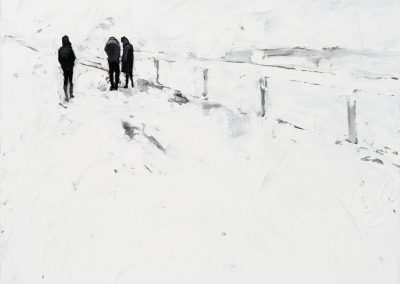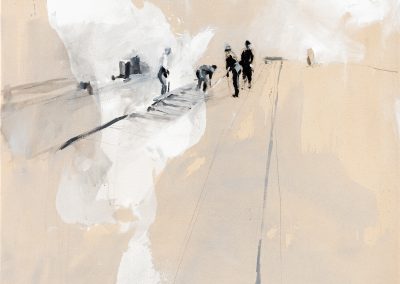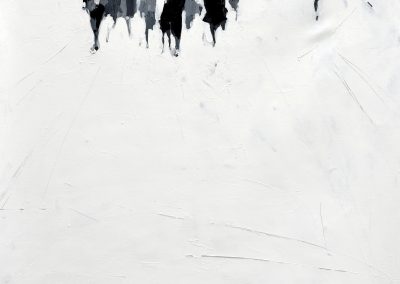Leszek Skurski
WORKS // INFO // BIOGRAPHY // EXHIBITIONS // FAIRS
WORKS
ARTIST
Leszek Skurski
Polish artist Leszek Skurski completed his studies at the Art Academy of Gdańsk. His monochrome painting approach revolves around figurative narration. His works tell many big and small stories that remain indiscriminately openended.
They show images of stasis, of pausing and halting when just carrying out an action or attitude, which the artist catches in concentrated form and translates into narrative density. He captures many transient moments of existence, alone or in community, on canvas; they appear like segments of a sequence, snapshots between the appearance and disappearance of characters on scene. The scenes shown are reminiscent of film stills or freeze frames that conjure up a content, a character, an atmosphere. This means: they point to a scene that began outside of what is depicted here and that continues after, a scene here captured in a single image and in this way coming to rest, so to say. In our era of dynamic information and image flow, the artist focusses time and again on the “one” image that tells an entire story. In doing so, he often zooms out, and so gets even closer to the action. By rendering his subject matter from a distance in small, at times blurry images, he allows our gaze to grasp the entirety of the scene, its concrete nature.
Time and again, Leszek Skurski places humans at the center of his work. Having now shown in numerous solo and group shown in Europe, the US and South Africa, he began his artistic career with a strong interest in the “living being”, at first in large format and strong colors, with a blurred physicality. Nowadays his figures are reduced to the essential: To a tiny black frame in an expressive stance and gesture, detached from its environs, rendered in a location that is at times only hinted-at, fragmentary, or – more often, in fact – entirely faded out. It is replaced by an abstract expanse of richly nuanced, light paint that spreads across the canvas. The achromatic color white, which is at the same time the sum of all of the colors in the light spectrum, takes up a large part of the space in Skurski’s canvasses. Its effect here is complex, open to projection. After all, white not only stands for emptiness and the void, silence or a hush, but also for the cerebral and spiritual realm, the intangible, unknown and undiscovered: Something that cannot be seen, that is absent. Our perception is sensitized to what isn’t there. Against these backdrops, everything is focused on the center: on the protagonists appearing individually or in groups, moving freely across the pictorial plane yet grounded in it, taking up space and generating it at the same time. They thus enter the stage in sharp Chiaroscuro – lonely together, isolated from one another, or in close connection. Here, in these abstract worlds, his small-figured scenes appear in varying narrative contexts that reveal themselves depending on perspective. We are faced with various scenes – some mundane, some less so – that appear “true” to life; they reflect much that is familiar and trivial, but also unique or spectacular and provocative scenes. Among others, we see a “meeting”, an “interview”, a “date”, a “parade” or an “arrival”, the paintings introduce a “help” or a “warning”. The artist consistently conjures up visual worlds that show us something seemingly inconspicuous, something interpersonal, while throwing up subtle questions in regard to what we’re looking at. Scenes of a convivial gathering or of isolation, of relaxation or alienation, of observation or surveillance, of trust or conspiracy. All these images offer a condensation of a reality that can be seen through different lenses. They all bear witness to palpable events while leaving plenty of room to what remains unseen. As it were, the stories the German-based artist tells seem to hail from a different time, a distant country, yet simultaneously always appear time- or placeless. They seem plucked, torn out of context. Everything remains open, unresolved. Only a few, but essential things come to light through the given “information” that develops in the viewer’s imagination much like a photo negative: Here being supplemented by a story we ourselves tell, that has its own beginning and its own end.
BIOGRAPHY
1973
born in Gdansk, Poland
1992 – 1997
studies of painting and graphic design, Academy of Fine Art, Gdansk with Prof. Wlodzimierz Lajming and Prof. Jerzy Krechowicz
1995
Art Award of the Ministry of Art and Culture Poland
1997
Diploma
EXHIBITIONS
SOLO EXHIBITIONS
2020s
2022
Gallery DOOIN, Seoul, Südkorea
Heimat Galerie, Saint Remy, Frankreich
Red Coridor Gallery, Fulda, Germany
2021
Gallery Barbara von Stechow, Mallorca
Red Corridor Gallery, Fulda, Germany
Galerie Crone, Wien, Österreich
2020
Gallery Barbara von Stechow, Frankfurt
Red Corridor Gallery, Fulda, Germany
Theo Art, Seoul, South Korea
2010s
2019
Ernst-Ludvig-Kirchner Verein, Fehmarn, Germany
Heimat Galerie, Saint Remy, France
Galerie Von & Von, Nürnberg, Germany
2018
Kunsttage Winningen, Germany
Gallery DOOIN, Seoul, South Korea
2016
JANKNEGT GALLERY, Laren, Niederlande
Galerie Von & Von, Nürnberg
Gallery JJ, Seoul, South Korea
2015
Gallery DOOIN, Seoul, South Korea
Hicks Gallery, London
2014
JANKNEGT GALLERY, Laren, Niederlande
Gallery DOOIN, Seoul, South Korea, 2014
Visages. Picasso, Magritte, Warhol…Centre de la Vieille Charité, Merseille, Frankreich
Alexandra Chiari, Merseille, Frankreich
2006 – 2015
Red Corridor Gallery, Fulda
2013
Galerie Von & Von, Nürnberg
„Einzelnachweise“, Vonderau Museum, Fulda
Leszek Skurski – Liens Fragiles, Marseille, 2013
2012
Galerie Image au Carré, Brüssel, Belgien
2011
colourblind Gallery, Köln
Galerie Image au Carré, Brüssel, Belgien
2010
„Der Lieblingstag“, colourblind Gallery, Köln
2000s
2009
Red Corridor Gallery, L‘Agulhas, RSA
Soho Gallery LLC, LA, USA
Lurie-Kavachnina Gallery, Miami, USA
2008
RED CORRIDOR going Mallorca, Sailer Galeria d‘Art, Mallorca Santaniy
2007
Galerie Prinsenhoek, Niederlande
2006
Scarlet Gallery, Greyton, RSA
2002
art Transfer, Kunststation Kleinsassen
Galerie Prinsenhoek, Niederlande
2001
Übergangen, Frankfurt a. Main
Verwaschene Spuren, Textilmuseum Crimmitschau, Deutschland (projekt „bettTuch“)
2000
Dorp Street Gallery, Stellenbosch, RSA
1990s
1997
Galerie Akademie der Schönen Künste, Danzig
FAIRS
PAN Amsterdam
Art.Fair Köln
Art Karlsruhe
Positions Berlin
Art Gent
SCOPE Basel
SCOPE Miami
RAI Amsterdam
























